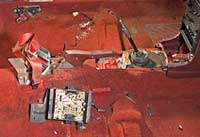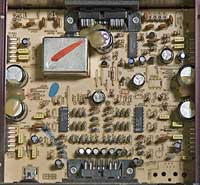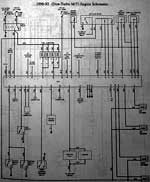Ugly Stick · 21 October 05

This adventure isn’t for clean freaks.
If you wash your hands after sneezing, own special brushes for washing root vegetables, and your household products predominately feature the words anti-bacterial this article is probably not your cup of tea.
On the other hand if you like looking deep into the underbelly (or knee-pits) of the world just to see what makes it tick, then come with me oh valiant reader.
Don’t worry about wiping your feet…
I started yanking out the clutch hydraulics the other day and realized that one of the bolts was inside the passenger compartment. No problem, should take a few seconds.
But to get to the bolt I had to remove some carpet, to get to the carpet there’s plastic shielding to be removed and to get to the shielding you basically do a turtle impression: lie upside down, wedged between steering wheel and seat, fighting with the shop light and basically rubbing your hair in whatever gunk the floor has collected over the last decade.
At least that’s how I’ve always worked on a car.
Ever since my first vehicle back in the 70’s (Ford Pinto…didn’t explode!) the first order of business is replacing the stereo and maybe putting in a fine shag carpet to impress the girls (70’s shag was particularly stunning).
Somewhere around the third or fourth car I realized that removing the seat made the job a whole lot easier. Four bolts, a wire connector or two and you are swimming with extra room!
That was last night’s adventure.
After some fifteen years in service a car collects a certain odor and wear no matter how fastidious the owner. Click the photo at the top of this article to see what I mean. Pulling out the seats and cracking open long neglected recesses exposes vast collections of coins, foodstuffs (the mice beat us to it this time), paper products, and ball point pen parts.
I made $1.13 an hour last night!

Under the passenger seat is the vehicle’s onboard “computer.” This is where all of those fuel injector wires originated, as well as the termination point for a handful of sensors and switches.
Not much to it, certainly not something we’ll be kicking back for a round of Half Life on.
UPDATE: Thanks to keen-eyed reader and fellow Probe owner, Nathan, we can now reveal the TRUE onboard computer.

Yes, it even looks more like a computer. What was I thinking? Turns out the other module is a 20 watt stereo amp and there’s another stereo related module behind the driver seat in the left rear wheel well.
This computer was found while removing the dash, which we’ll be getting to soon enough. A key distinguishing mark was the huge bundle of cables from the engine compartment leading up to it…
If you use your new found schematic reading skills you’ll find that the engine control computer is hooked to a few solenoids (like a relay but used to open/close mechanical valves/levers), a bunch of switches, and some strange looking resistor things.

The resistor things are sensors: an electrical thermometer to measure engine temperature, a moveable resistor “arm” that measures the position of the throttle, or another that measures how much exhaust gas recirculation (EGR) is going on.
An interesting one, though, is the air flow meter. This tells the computer how much air is entering the intake manifold.
How do you measure air? Well, you could use a propeller mounted on a small generator and measure the voltage it produces. That’s mechanical and prone to failure (imagine the jostling it gets driving the potholes of Boston) and has too much lag time. For Eve they are using a non-mechanical means of measuring it, which I’ve always thought was quite clever.
I’m doing a bit of speculation here, since there’s probably a few ways to do this, and guessing that it’s similar to hot wire anemometers used to measure wind speed. This is done by putting a controlled current through a wire where the resistance of the wire is proportional to its temperature. As air flows over the wire heat is dissipated and the resistance changes, causing more current to flow. The computer, in charge of this current flow, makes a note of it and sends down a communiqué to Scotty:
“Aye, Captain, but the dilithium crystals canna take anymore!”
Back when I worked for the FAA I studied a unit which not only measured the speed of airflow but—by using hot wires perpendicular to each other—could also determine the wind direction. All without any moving parts.
But we don’t need any of that.
There’s a little bit of rust and corrosion under the seats and inside the center console. Given the shape of the rest of the car I’d have to attribute this to spilled coffee and coke. The seat belts are up for redesign/replacement. The center console and dash are in great shape, almost a pity to take them apart.
The carpet has got to go.
Maybe in the quest for weight savings I can replace the seats?




The premium sound system package that was offered with the Probe included an amplifier that delivered 20-watts per channel. It is located under the front passenger seat. Normally, installation kits will include a wiring harness that is used to bypass the factory amplifier. This, however, is unnecessary unless you are worried about loss of sound quality.
yeah you are correct on the operation of a standard mass air flow meter… usually supplied with 5 volts… all onboard sensors run 5 volts reference signals… the voltage returning to the computer through a separate wire is compared to the reference signal and a computer algorithm takes care of calculating the airflow.
have you ever considered a strain guage for air flow. I built one many years ago in electronics class. the more pressure applied the less resistace. they are typically setup in a bridge. mine was used for air pressure/flow coming out of an air line that was hooked to a pressure regulator and it was accurate to within 1 psi. pretty cool but your idea could be more likely. one note to add, if you own a chevy or gmc check your mass air flow for a honeycomb screen, if its got one gently break the edges loose and remove it. I did it on a 6.0 liter chevy pickup and it got 2 mpg better fuel economy but thats just for the gas burners who are reading. oh and by the way I am loving these articles. keep it up.
where is the E C M on a ford probe 1993??